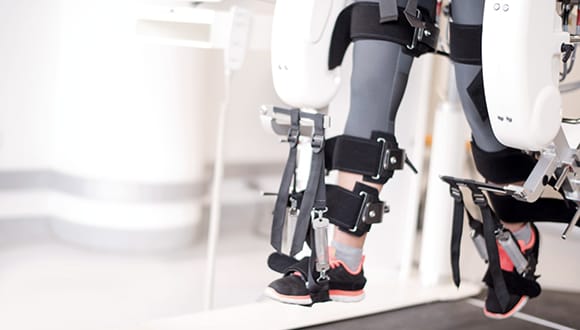Robots helping patients recover from a stroke
In a new era of rehabilitation, robotic technology is helping people who’ve had a stroke regain their movement, physical strength and independence.
Health Agenda magazine
January 2019
Imagine suddenly losing the ability to speak, walk, drive, or dress and feed yourself. Unfortunately this scenario can become a reality for some, as around 150 Aussies have a stroke every day, reports the Stroke Foundation.
But the brain’s ability to form new connections – known as neuroplasticity – means you could possibly recover varying degrees of function after having a stroke. And robotics is here to help.
Rehab robots are being used to provide physical support and assistance according to your needs. They can, for example, attach to your arm or leg and help you make a movement and, as you improve, increase resistance.

What is a stroke?
Stroke is one of Australia’s leading causes of death and disability. An estimated 394,000 people have had a stroke at some point in their lives, according to figures from the Australian Bureau of Statistics. That number is predicted to reach one million by 2050.
A stroke happens when a vessel supplying blood to the brain becomes blocked, known as an ischaemic stroke, or ruptures and bleeds, known as a haemorrhagic stroke. Both types of stroke can lead to part of the brain dying due to lack of oxygen. This then results in the sudden loss of function of whatever body parts are controlled by that area of the brain.
Common effects of stroke are:
- paralysis down one side of the body
- swallowing difficulties
- problems with speech, vision, attention and memory.
The Stroke Foundation reports that around 65% of people who’ve had a stroke experience a disability that hinders being able to carry out everyday activities independently, like walking, dressing and eating.
Relearning movement after stroke
For most people, rehabilitation is vital for recovery and regaining function. It can begin in hospital and continue in a rehab unit and at home.
The type of rehab will depend on how and which body function has been affected. For example, it could help you to relearn how to walk through strengthening and stabilising your leg muscles.
It’s important to get the right intensity and repetitions of movements in rehab. The necessary repetition can be difficult to achieve in rehab settings where staff time and energy is limited. But robots can help people complete repetitions that would otherwise be unrealistic.
More than two-thirds of people have reduced arm and hand function after a stroke, reports an article published by Cochrane. Melbourne occupational therapist (OT) Vicki Abraham runs an upper limb rehabilitation clinic that uses robots. Her clinic has 2 robots: one each for shoulder and finger retraining.
The therapists set clients up and program the computer to provide the level of assistance they need.
"We can get 600 reps in 20 minutes, which is what you’re wanting to achieve in order for the messages to get back to the brain,” says Abraham. “Repetition increases the strength of the new patterns [but] as an OT… you can’t sit there and bend your clients’ fingers and extend them out [that] many times."
Professor Susan Hillier, the Dean of Research at the University of South Australia and clinical council member of the Stroke Foundation, says that robotic training isn’t for everybody but can be ideal for people with very limited function. And as soon as someone can do the movements themselves, they no longer need the robots.
Future trends
One of the barriers to wider implementation of robotic technology is the set-up cost, which can be hundreds of thousands of dollars, Prof Hillier says. Then there’s the ongoing cost of training staff to use it.
At this stage, only a handful of Australian hospitals have the more sophisticated technology.
Prof Hillier expects robots to become cheaper, better at mimicking real movements, and more portable. Work is continuing worldwide on exoskeletons with wearable motors, eliminating the need for use with a tabletop or bulky frame, she says.
While robotics will never take the hard work out of rehab, they might help people take their first steps towards stroke recovery.
Related Articles
How to prevent a stroke
One in six of us will have a stroke during our lifetime, but they’re largely preventable. Learn how to protect yourself and how to recognise the signs of stroke in others.
Recovering from a stroke: life-saving treatment and beyond
Fast, specialist treatment can be the difference between life and death. Alex Wright is living proof.
How physiotherapy works
Physiotherapist Phil Calvert, Regional Manager, Physiotherapy, from the Women’s and Children’s Health Network in South Australia explains.
Robots teaching social skills to children with autism
For children with autism, processing emotions and social cues can be a real challenge. Robot teachers may offer the right kind of support.